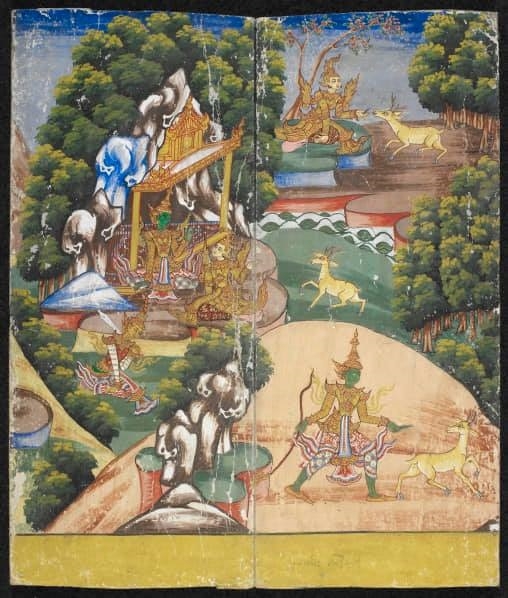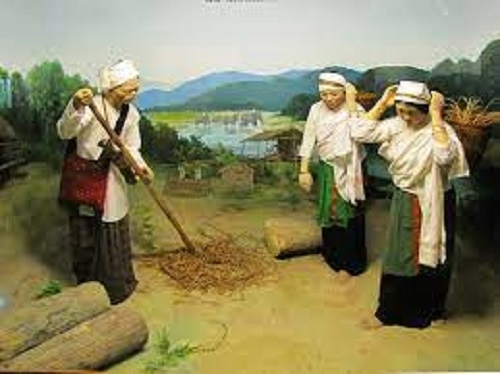Ramayana in North-east India – II : The Khamti Ramayana
21 Apr 2021 16:04:32
Arunachal Pradesh situated at the extreme northeast corner of India is a “Land of the Rising Sun”. Surrounded by beautiful dawn-lit golden sky-piercing mountain peaks and flowing rivers this ‘heaven on the earth’ has been home to many janjatis (Scheduled Tribes). Prominent among them are the Monpas, Sherdukpens, Akas, Nishis, Hill Miris, Adis, Apatanis, Tagins, Mishmis, Singphos, Khamtis, Noctes, Tangsas, Wanchoos and so on. In addition there are a number of clans and sub-clans of these janjatis.
The state of Arunachal Pradesh was earlier known as ‘North East Frontier Agency’ (NEFA). It was changed after the 1962 Chinese invasion and the new nomenclature “Arunachal Pradesh” was brought in vogue granting ‘Union Territory’ status to this region in 1971 when the northeastern region was reorganized. In 1982 February the full-fledged state of Arunachal Pradesh came into existence along with the State of Mizoram in the north east India.
It was the visionary leadership of the then Prime Minister Indira Gandhi that saved Arunachal Pradesh from the onslaught of religious conversion indulged in by the Christian Missionaries and the Church organizations. As soon as NEFA was elevated as a Union Territory status she chose Prem Khandu Thungan, a Buddhist by faith as Chief Councilor over a converted senior leader Tomo Riba from Adi community. She also allowed Ramakrishna Mission, Arya Samaj and Vivkenanda Kendra to start their activities among the janjatis of Arunachal Pradesh way back in the 1970s.

As against this, the first Prime Minister and her father Jawaharlal Nehru had appointed Dr. Verrier Elwin, an Anglican priest who had come to India as a missionary; later joined the movement of M K Gandhi after being expelled by his Anglican Church, and who worked among the Bastar Janjatis, as Advisor to Prime Minister on Tribal Affairs. In his “Philosophy for NEFA” Dr. Elwin proposed to ‘preserve the tribal culture’ of these janjatis as it provided a clue to the ancient civilization. But his ulterior motive was to bring them to the fold of Christianity! He set up the research department in 1956 to carry out sociological and anthropological research among the people in various parts of Arunachal Pradesh.
These janjati people of Arunachal Pradesh have strong connection with the Indian history and culture since the hoary past. Ample references of their association with people, culture and traditions of mainland India are available in the archaeological excavations being carried out in the last so many years. Particularly, there are archaeological evidences that suggest a close relationship and strong connection of these janjatis with mainland Hindu culture, tradition and history from the period of Mahabharata to the reign of Emperor Harshavardhana of the 7th century. I will discuss about them later.
Among the several janjatis of Arunachal Pradesh reference about their association with the story of the ‘Prince of Ayodhya’ is found among the Khamti people who inhabit the Lohit district of the state. The Aka people of West Kameng district trace their origin to King Bhaluka who is considered as ‘Jambavana’ the Bhaluka warrior in Rama’s army. There is also a town by name ‘Bhalukpong’on Assam-Arunachal Pradesh border on the Tezpur-Bomdila road. But there is no strong evidence to confirm this speculation.
However, the Khamtis of Lohit have strong association with Ram Katha. They are originally believed to be from the northwest Myanmar region. They had migrated to Assam and settled in Arunachal Pradesh’s Lohit district and East Siang district. Among the two Scheduled Tribe communities of Arunachal Pradesh who have their own script and language, the Khamtis or Lohit district are more advanced and educated. The other community is that of the Monpas of West Kameng District surrounding Tawang and Bomdila. Both these communities are Buddhist by faith – the Khamtis following the Hinayana sect while the Monpas follow the Mahayana sect of Buddhism. According to the historical records, the Hinayana school of Buddhism had originally migrated to Myanmar from Sri Lanka and later entered India through the Khamti people.
According to Chau Khouk Manpoong, a Khamti scholar, the Tai-Khampti language is a living language. It is widely spoken and used by the members in North-East India. Tai-Khampti literature (Liklai) is very rich. The literary works also include dramatic performing arts with theme usually drawn from Jataka tales (Buddha's birth stories) and epics of Ramayan and Mahabharata. These volumes are written in scholarly poetical style having flowing rhyme rich in assonance and alliteration.

Khamtis are supposed to have migrated to this part of India around the later part of the 18th century from the Bor-Khamti region near the Irrawaddy River. This Bor-Khamti region is described by Alexander Mackenzie as the mountainous region interposing between the eastern extremity of Assam and the Valley of Irrawaddy River. During the British Occupation period, these Khamtis offered tough resistance to the British army in 1839. They in association with the Singpho people attacked the British command headed by Col White and killed him along with 80 of his soldiers.
Khamtis are good carvers. Their temples are said to be wonderful examples of local wood carvings. The institution of priest exists among the Khamti people and they are good at carving figures of snakes, dragons etc. in wood, bones and ivory. Khamtis are the only people in Arunachal Pradesh to have their own version of Ram Katha. Known as “Cao-Alang-Lamang” (The Story of Rama’s Incarnation) or “Lik-Cao-Lamang” is written and the manuscript is preserved in the Dikrong Borkhamti Buddhist Vihara of Narayanpur in Lakhimpur district of Assam. As the Khamti Ramayana has traveled from Myanmar to Arunachal Pradesh it is but natural that it should have the narratives of its place of origin. The appearance of the Story of Sri Rama in Myanmar can be traced bas to the reign of King Anawrahta who ruled from 1044-77 AD and who founded the Burmese empire.
The first written version of Ram Katha was compiled from the oral circulations in 1775 by U Aung Phyo as ‘Rama Thagyin’ (Songs from the Ramayana). A three-volume parabaik manuscript Ramayana, ‘Rama vatthu’ was written in 1877. The episode of ‘Golden Deer’ (सुवर्ण मृग) described in the Burmese version of Ramayana is identical to its depiction in the Tai-Khamti Ramayana “Lik Cao-Lamang” kept in the Buddhist monastery at Barkhamti village of Narayanpur in Lakhimpur district of Assam. The Assamese rendering of the Khamti Ramayana was done by Phanidhar Bora and published in 2001.
The ‘Golden Deer’ episode is described in the Burmese parabaik manuscript of Ram Katha dating back to the 1870s like this:
“The ten-headed demon king of Thiho i.e. Sri Lanka, Dathagiri (Ravana) sends Gambi (Maricha) in the disguise of ‘Shwethamin’ (Golden Deer) to ‘Thida’ (Sita). Conceding to Sita’s persuation, Rama left her under the protection of his brother ‘Letkhana’ (Lakshman) to catch the deer for her”. Besides this, the Khamtis have numerous folk tales based on the epics of Ramayana and Jataka tales of Bodhisattva.
.
.
